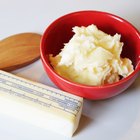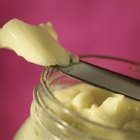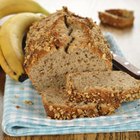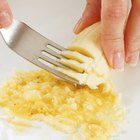
Buttercream frosting is a treat for cake lovers, because butter's low melting point means it literally melts in your mouth when eaten. However, because butter melts within a relatively narrow range of temperatures, buttercream can sometimes be complicated to make. Your icing might contain lumps of unmixed butter, or it might separate into an ugly, lumpy mess as it mixes. Other ingredients such as sugar can also cause lumps, if they're mishandled.
Just Beat It
A reliable solution to lumpy buttercream is more mixing. Put the frosting back in your mixer's bowl and let it run on a medium-to-high speed until the buttercream's consistency corrects itself. The action of the beaters softens nuggets of butter and mixes them in, and will bring butter and shortening together if you've used both fats. If your buttercream has "broken," with the fat separating from the other ingredients, long, patient beating will bring it back together. Lumps caused by crystallized sugar syrup are too solid to dissolve through beating, and must be picked out by hand. Alternatively, force the buttercream through a fine sieve to remove the sugar lumps.
Tweak the Temperature
A common reason for a buttercream to break into a lumpy mess is a problem with the temperature of its ingredients. If your butter is too soft or too hard, it might not combine properly with the other ingredients. If you're making a meringue-based buttercream, you might have started adding butter before the egg foam had cooled completely. In either case, your buttercream must be at approximately room temperature. If your mixer bowl feels cold to the touch, warm it gently with a hair dryer as it mixes. If it feels warm to the touch, chill it with a freezer gel pack or a bag of ice cubes pressed to the side of the bowl.
Getting the Butter Right
There's an old saying that "an ounce of prevention is worth a pound of cure," and that certainly applies to buttercream. Getting your butter to the correct consistency is the most important way to prevent lumpy buttercream. Ideally your butter should be firm enough to hold its shape, but soft enough to mix easily. If it's too soft, flatten it and return it to your refrigerator for 15 to 20 minutes until it's firm. If it's too hard, beat it in your stand mixer for several minutes until it's softened and pliable. At that point, you can add some shortening if you wish to improve the buttercream's ability to withstand hot, humid weather.
Getting the Rest Right
If you're making simple buttercream with powdered sugar, sift or sieve the sugar before adding it to the butter. That simple step prevents lumps of powder from marring your buttercream. If your buttercream is a more sophisticated recipe using sugar syrup, avoid drizzling the hot syrup onto the sides of the mixer bowl. The cool bowl can cause lumps of hardened sugar, which won't beat out. If you're making a meringue-type buttercream, be patient and beat the meringue until it's completely cooled before adding the butter. In every case, with every type of buttercream, scrape down the sides of the bowl repeatedly to ensure that the ingredients mix well.
Related Articles

How to Keep Your Buttercream Icing With ...

What to Do If My Buttercream Frosting ...

How to Make Thick Marshmallow Cream

How to Soften a Stiff Buttercream

How to Stiffen Frosting

How to Fix Grainy Whipped Ganache
Best Homemade Cream Cheese Frosting

How to Add Meringue Powder to ...

How to Cream Butter Without a Mixer

How to Quickly Thaw Butter

How to Fix Mayo With Broken Emulsion

How to Make Mocha Buttercream Frosting

Help: How Can I Thicken Lemon Icebox ...

How to Replace Vegetable Oil for Baking ...
How Can I Prepare Whipping Cream Ahead ...

How to Fix Curdled Whipped Cream

How to Make Butter Sugar Cookies

Making Chocolate From Cocoa Powder

How to Bake Cookies With Bananas ...

How to Get Hot Pink Colored Frosting
References
- The Professional Pastry Chef; Bo Friberg
- The Kitchn: Recipe Rescue! How to Save a Broken Buttercream
- King Arthur Flour: Blissful Buttercream -- The Beautiful Side of Baking
Resources
Writer Bio
Fred Decker is a trained chef and prolific freelance writer. In previous careers, he sold insurance and mutual funds, and was a longtime retailer. He was educated at Memorial University of Newfoundland and the Northern Alberta Institute of Technology. His articles have appeared on numerous home and garden sites including GoneOutdoors, TheNest and eHow.
Photo Credits
Jupiterimages/Photos.com/Getty Images